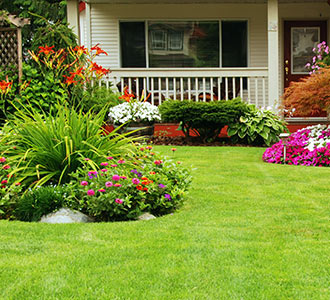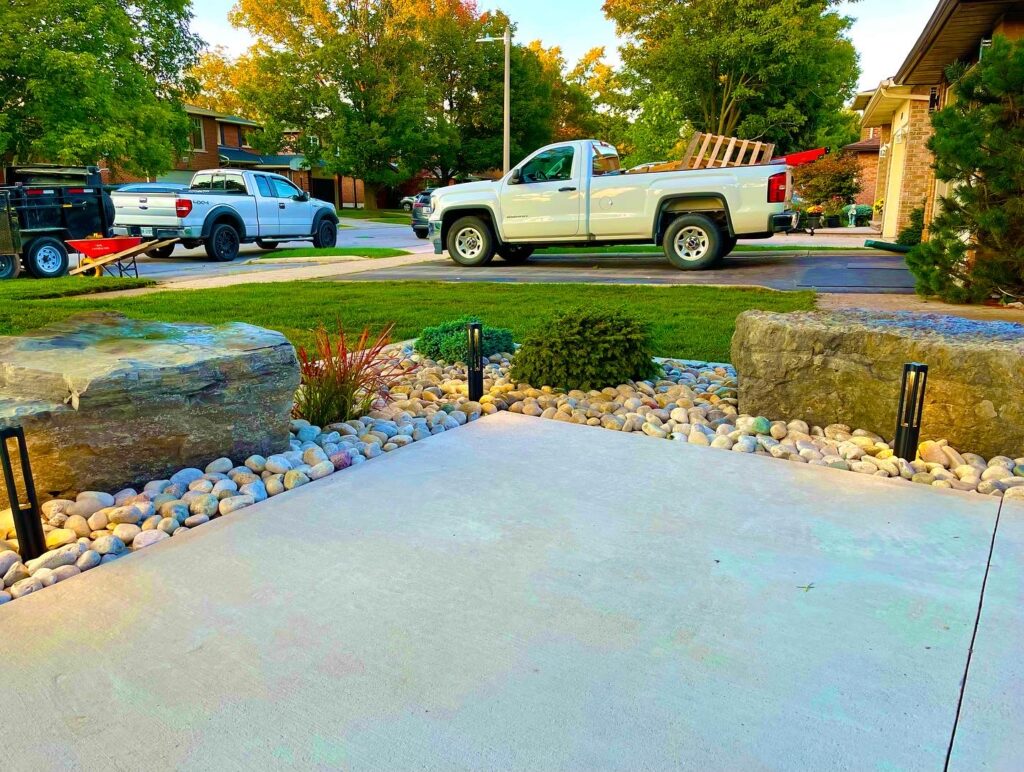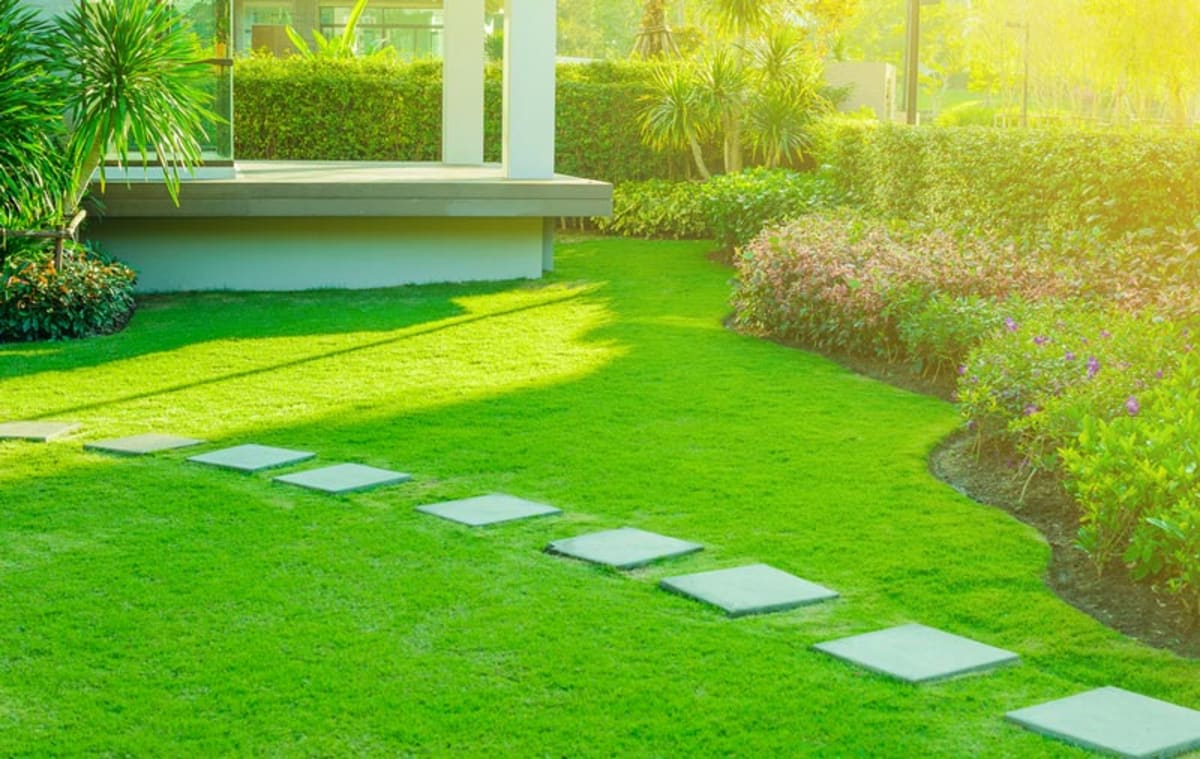Understanding the Comprehensive Extent of Works in Specialist Landscaping Services
The considerable extent of expert landscaping services incorporates a variety of essential elements - landscaping services. It includes landscape design principles, plant selection, and hardscaping attributes. Additionally, it resolves watering systems and maintenance approaches. Each aspect plays an essential role in developing practical and aesthetically pleasing outdoor spaces. Comprehending just how these components interact can reveal much regarding the art and scientific research of landscape design. Nonetheless, the journey into this intricate field is just beginning
Landscape Design Principles
Reliable landscape layout concepts are crucial for creating unified exterior spaces that enhance both aesthetic charm and performance (Learn More). These principles lead the setup of elements within the landscape, guaranteeing a cohesive aesthetic experience. Trick components consist of equilibrium, which disperses aesthetic weight evenly; proportion, which relates the dimension of numerous components per various other and the space; and unity, which develops a sense of wholeness through consistent themes and materials

Plant Selection and Installation
In the domain of expert landscaping, plant selection and installment play a critical role in achieving a growing garden. Stressing indigenous plant advantages, seasonal considerations, and the particular soil and sunlight demands of each varieties guarantees a lasting and visually pleasing landscape. Careful preparation in these locations not only enhances biodiversity however also advertises lasting eco-friendly wellness.
Native Plant Advantages
Why should property owners think about native plants for their landscaping tasks? Indigenous plants offer various benefits that enhance both looks and environmental sustainability. They are well-adapted to local environments, calling for less water and upkeep compared to non-native species. This durability lowers the demand for chemical fertilizers and pesticides, advertising a healthier environment. Furthermore, indigenous plants supply habitat and food for neighborhood wild animals, consisting of pollinators, which can increase biodiversity in houses. Their knowledge with neighborhood soil and weather problems likewise leads to far better development rates and durability. By picking native plants, homeowners not just develop aesthetically appealing landscapes yet also add to ecological preservation, making a positive effect on their regional setting. Subsequently, native plants represent a clever choice for landscape design jobs.
Seasonal Plant Considerations
House owners who have actually accepted indigenous plants in their landscape design can further enhance their exterior spaces by thinking about seasonal plant choices. By integrating plants that prosper in details periods, they can create aesthetically appealing and dynamic landscapes throughout the year. Springtime may usher in lively blossoms like tulips and daffodils, while summertime can display lush foliage and vibrant perennials. Autumn introduces a palette of cozy tones with goldenrods and asters, while winter months can be highlighted with evergreens and decorative grasses for texture. Specialist landscaping companies typically recommend picking plants that not only enhance existing native varieties but likewise give year-round passion and support neighborhood wild animals. This thoughtful approach to seasonal plant choice ensures a consistently evolving and sustainable garden setting.
Soil and Sunlight Requirements
Successful landscape design rests on comprehending the particular soil and sunlight demands of plants. Various species thrive under differing problems, calling for a cautious evaluation of both factors throughout the choice procedure. Dirt types, such as sandy, clay, or fertile, impact water drainage, vitamins and mineral schedule, and root development. Additionally, pH levels can influence plant health, requiring soil testing to establish suitability. Sunlight needs differ significantly; some plants thrive completely sun, while others favor partial or complete color. A professional landscaping company considers these components to ensure peak growth and aesthetic appeal. By lining up plant choices with the setting's details features, landscapes can attain sustainability, strength, and aesthetic harmony, eventually bring about successful plant facility and long-lasting maintenance.
Hardscaping Attributes and Construction

While landscape design commonly stimulates photos of lush greenery and dynamic flowers, hardscaping functions play an important duty in defining outside spaces. These elements, that include patio areas, sidewalks, retaining walls, and attractive stonework, supply structure and performance to yards and yards. Hardscaping utilizes materials such as concrete, wood, stone, and brick, enabling diverse layouts that complement the all-natural landscape.
The building of hardscaping features needs careful planning and execution to assure longevity and visual appeal. Specialists examine site conditions, drainage, and spatial relationships to develop natural outdoor environments. Appropriate setup strategies are crucial, as they prevent concerns like erosion and moving over time.
Incorporating hardscaping not just boosts the aesthetic rate of interest of a home yet additionally assists in outside tasks, making it an essential aspect of extensive landscaping services. Inevitably, thoughtful hardscaping adds to both the performance and beauty of exterior areas.
Irrigation Solutions and Water Management
Efficient watering systems and water administration are important elements of professional landscape design, as they assure that plants receive the essential hydration for excellent development. These systems can vary from basic drip watering setups to sophisticated automated sprinkler systems, made to fulfill the details requirements of varied landscapes. Proper official site water management not only enhances water use, minimizing waste, yet additionally improves plant health and decreases disease risks.
Landscaping experts evaluate numerous elements, consisting of soil type, plant types, and neighborhood climate, to create customized irrigation solutions. Furthermore, integrating rainwater harvesting techniques can further boost sustainability and performance. Routine maintenance of irrigation systems is important to maintain capability and avoid leaks, which can bring about water loss and increased expenses (Learn More). Inevitably, a well-designed irrigation system plays a critical function in maintaining the aesthetic charm of outside rooms while promoting ecological stewardship within specialist landscaping techniques
Grass Care and Upkeep Methods
Grass care and maintenance techniques are fundamental for accomplishing a lush, healthy yard that improves the overall landscape. These strategies incorporate different techniques focused on promoting optimal growth and visual charm. Normal mowing is crucial, as it motivates thick, also development while avoiding weeds from developing. Additionally, proper fertilization offers required nutrients, with applications tailored to the specific lawn kind and soil problems.
Watering methods must concentrate on deep, irregular irrigation to motivate origin advancement, while oygenation enhances soil structure and promotes nutrient absorption. Bug and disease management is likewise essential; determining problems early permits efficient therapies that decrease damages.
Overseeding can revitalize thin or damaged yards, improving density and shade (landscaping services). By executing these targeted lawn care approaches, landscape design specialists can guarantee that lawns remain healthy and vibrant throughout the periods, greatly adding to the overall charm of the building
Seasonal Landscape Care and Maintenance
As the seasons adjustment, proper landscape treatment comes to be important for preserving the health and wellness and charm of outside rooms. Each season presents one-of-a-kind challenges and needs. In spring, landscape specialists concentrate on trimming, growing, and fertilizing to urge development. Summer demands normal watering, weed control, and insect administration to protect newly developed plants.

Throughout the year, seasonal landscape maintenance assurances that outside areas remain visually enticing and healthy and balanced. Professional services can give tailored maintenance plans that adjust to the certain needs of each season, allowing building proprietors to enjoy dynamic landscapes year-round. On the whole, seasonal treatment is a vital facet of specialist landscape design that promotes long life and visual worth.

Lasting Landscaping Practices
A growing variety of building owners are embracing lasting landscape design methods to create eco-friendly exterior areas. These practices concentrate on preserving resources, enhancing biodiversity, and decreasing ecological effect. Native plants are frequently selected for their low tide needs and compatibility with neighborhood environments, reducing the need for chemical plant foods and pesticides. Rain yards and permeable paving are utilized to take care of stormwater runoff, promoting groundwater recharge and lowering disintegration.
In addition, lasting landscape design incorporates organic horticulture strategies that focus on dirt health and wellness and promote all-natural pest control. Reliable irrigation systems, such as drip irrigation and rainwater harvesting, help maximize water use. Furthermore, landscape designers increasingly support for using recycled materials, such as recovered wood and rocks, to minimize waste. By adopting these lasting techniques, homeowner not just add to ecological conservation however also create visually pleasing settings that can love very little upkeep.
Frequently Asked Concerns
Just how Lengthy Does a Landscaping Job Normally Require To Full?
Normally, a landscaping project can take anywhere from a few days to several weeks to finish, relying on the task's size, complexity, and style demands. Variables such as weather and source schedule also influence timelines.
What Aspects Impact the Cost of Landscaping Services?
Various variables affect landscaping solution prices, consisting of project size, design intricacy, material high quality, labor expenditures, geographical place, and seasonal need. Each component contributes distinctively to the general financial needs of a landscape design project.
Are Landscaping Solutions Available Year-Round?
Landscaping services are generally offered year-round, although accessibility may vary based upon area, seasonal climate condition, and particular service offerings. Some services could be limited throughout extreme climate or off-peak seasons.
Do Landscape Design Business Deal Warranties on Their Job?
Lots of landscaping firms do offer service warranties on their job, which can differ in size and coverage. Clients are encouraged to ask about details terms, guaranteeing they recognize what is ensured and any problems that apply.
Can I Layout My Landscape Without Professional Aid?
Yes, individuals can develop their landscapes without professional help. Nonetheless, they may lack expertise in plant selection, design, and environmental factors to consider, potentially bring about much less reliable layouts that could require expensive modifications later.
In the domain name of professional landscape design, plant choice and setup play a vital role in attaining a flourishing yard. Homeowners that have embraced native plants in their landscaping can better boost their outside rooms by thinking about seasonal plant choices. Effective landscaping hinges on understanding the specific dirt and sunshine demands of plants. Reliable watering systems and water administration are vital components of expert landscape design, as they assure that plants get the necessary hydration for optimal growth. Landscaping specialists evaluate numerous aspects, including dirt type, plant varieties, and local environment, to establish tailored irrigation services.